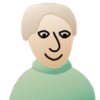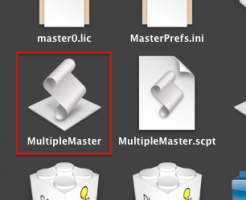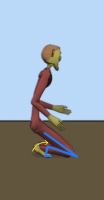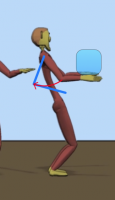-
Posts
635 -
Joined
-
Last visited
-
Days Won
3
Content Type
Profiles
Forums
Events
Everything posted by markw
-
Yes, all the standard Mac methods for opening an app work. Make sure you open the MultipleMaster App and not the script that it was made from. I've outlined the App in the screen shot.
-
Hi Simon, Its really simple actually, all MultipleMaster is realy is an AppleScript that tells the OS to launch 2 instances of A:M. (With if, memory serves, a 30 second gap before the second instance is launched.) So if you are rendering directly from A:M now, double click on MultipleMaster and you should get 2 more instances of A:M to do with what you will as the original caries on rendering. How many instances you can optimally run will depend on how many CPU cores you have to play with. I must say that since the inclusion of Netrender with A:M, I haven't used MultipleMaster for some time now. As Netrender runs independently from A:M, I tend to let it handle all my rendering needs which frees up A:M for doing other things.
-
Yes Robert and Nancy have got it I think. Radiosity is normally Off by default and somehow you've inadvertently turned it on. (Interesting effect though!) Turning it OFF and all is well again.
-
Hi Simon, On clip Kneel_Lift_002, In the first snapshot from it here, at the beginning I would say that you could still rotate the heals further up and forward to get a more realistic gap between feat and shins. The second snapshot is from around frame 30. This pose seems out of place as is. But if he were to have something heavy in his hands then it makes a lot more sense! However I would bring the arms back more in to the body. When people lift heavy things they tend to keep all that extra mass tight in to the body as they lift. Unless of course they want to put their backs out!
-
Well I couldn't help but have a go at this too! Here's my quick take (it could be tweaked more) on going from a kneel to standing. This is in isolation and without any context, which would obviously effect the specifics of someone doing it. KneelToStanding.mp4
-
I see its yoda64's birthday today! Happy birthday Steffen. Have a good one!
-
Hi KJ'd Beast, Will Sutton has some good video tutorials on flattening and decaling a model on his YouTube channel, where he takes you through decaling the Hipogyraf From the Oz movie. Part 1 is here: http://www.youtube.com/watch?v=AXfP9jpMmlE Also if you have the Extras DVD there is a tutorial in there by Jim Talbot on the same subject. Path: Extras DVD > Tutorials > Decaling > Jim Talbot
-
I think the software you are thinking of Gerald is what used to be the very reasonably priced PHhoe. It was quite capable and more or less within the budget of a hobbyist who needed it. Now sadly it is no longer with us. Its replacement PFTrackX is by all accounts even better at what it dose but much, much more expensive at 2,499€! Still, if any want to look at it or their other software you can find it here: http://www.thepixelfarm.co.uk/
-
What do you think about the other possible bug Robert, that of the "flickering" motion of the pupil bone when it is set as a Boolean Cutter? In Stefen's original model he has the pupil bone set to be a Boolean Cutter. Or could this just be an incorrect use of a Boolean and they're not supposed to be used like this? Here are two renders from your project file. One with and one without Boolean turned on in the pupil bone. BooleanCutter_OFF.mp4 BooleanCutter_ON.mp4
-
I think the only thing you possibly did "wrong" as it were was to not start by opening a new On/Off pose to set things up in first. But the rest I think has shown up two possible bugs; 1: A bone set to be a Boolean Cutter won't track a surface when it is then constrained to a surface by a Surface Constraint. 2: If the Aiming bone in a Surface Constraint has an additional Aim At constraint applied to it, so that it follows/is controlled by a target null. The bone that was constrained to the surface in this Surface Constraint setup stops moving. I can submit this as a bug report, unless any one else here thinks I have miss evaluated some aspect of this.
-
Well I think this can still work for you Visping. From memory this is what I did yesterday in a little more detail. (I shall omit the dead ends and falls starts!) First, after looking at what you had already, I tried to delete your 'Pose1 Relationships' under 'User Properties Relationships' in the PWS, however every time I tried that A:M would crash on me. (This may or may not have been completely necessary but I wanted to make sure that no other settings could be interfering with a new setup). In the end I had to resort to removing it in a text editor before reloading it into A:M. Next I setup the surface constraint again as per the TechRef (though Robs video is a much clearer demonstration of what to do) in a new On/Off pose. But I still got that odd jumping of the pupil. Then I turned OFF 'Boolean Cutter' in the pupil bone. And it was after doing this that I got NO jumping of the pupil and everything worked as it should. Last I tried to set up the AimAT constraint so the Nulll could direct the eyes and it was only here, as I noted before, that something broke. When I tried to introduce the AimAT constraint to allow the EyeTarget null to control the direction of where the eyes looked, the pupil stopped moving completely. But it did work correctly before tying to add the AimAt. So a simple workaround would be not to use the EyeTarget null to control where the eyes are looking. Make the Aiming Bones in the eyes a bit bigger so they're easier to see and animate those directly to get the pupils moving. Yes you will be animating each eye separately but it is effectively only one extra bone you will have to work with. On the plus side having separately controlled eyes opens the possibility of making their "performance" more expressive, say going cross-eyed, looking in different directions at once or even spinning round independently after being hit on the head!
-
Hello again Vesping, I would agree with Gerry, delete what constraints you've set up for the eye and start again, this time doing it as an On/Off pose. I tried it earlier today and that worked. But there is a "but…" When I tried to constrain the pupil AimingBone with an AimAt constraint to the EyeTarget null, the Surface Constraint would stop working. The AimingBone would track the EyeTarget correctly but the pupil would then remain resolutely still! Not sure why this happens but maybe someone else here can figure that one out. I also saw the you have the pupil bone set as 'Boolean', Is that intentional? As for the TechRef, it dose contain possibly nearly all there is to know about how A:M works but as a "How To Do 'X'" it leaves a lot to be desired in places!
-
Hi Visping, I don't know if this will be of help to you directly but on the Extras DVD there is a tutorial on making irregular shaped eyes, i.e. oval shaped. If you have the Extras DVD the path to it is; Tutorials > Bootcamp > EyeTut.html
-
Well this is all very sad, if not unexpected, news about the Mac version of A:M. :( So first let me also thank Steffen for all he has done to keep it going this long, a remarkable achievement. But dose Mac A:M have to die just yet? The original problem, that of A:M not launching on OS10.9, Steffen has managed to fix. Maybe its not a pretty fix by Steffens standards but it works. So if that was the only problem with it on 10.9 why can we not carry on using it for now? Whilst I too have to agree that it is no longer worth the time and effort to progress the Mac version further, in terms of trying to keep up with Apple forever moving the goal posts with new versions of OSX, could A:M not at least be maintained as far as keeping it working for OS10.8 and indeed 10.9 if the launch problem was the only major incompatibility? But make it clear to everyone that this is it, the last version of Mac A:M. When next Apple tinker with the OS there will be no new update. I can see that someone using A:M commercially will not want to be using legacy software like this, but some of us existing hobbyist users might be able to get another year or two out of it yet. There is also the question of v18, Steffen has already got an Alpha version out that some here are currently using. Is that to be spiked as of now? That would seem a shame and a waste of the work he has put into it so far.
-

working on converting older model that will not
markw replied to johnl3d's topic in Tinkering Gnome's Workshop
Interesting…, I just "Saved As…" him from the PWS in the Dance project that's on the Extras DVD and he opens fine for me in v17g. I would say though that it looks to me like whoever rigged him got him to a usable state for them and didn't feel the need to clean up the rig. Just opening him in an Action and he looks like Cps for fingers and body are not assigned but actually they are, its just that those bones have been hidden for some reason? So some investigating and cleanup is needed but he works. Any way here's my copy of him John if you want to try it. Martian_2.zip -
Now that's an interesting idea Rob! Might I also suggest that when working with Project files instead of just automatically saving over a model file when you save the Project, (as noted by Nancy, when saving Projects A:M will overwrite a model even when it is NOT embedded in the Project), before saving the Project A:M would ask you which of your suggested save option should be applied to the models in it. Another possibility might be that we have a Preferences setting to instruct A:M how to save models when working with Projects.
-
Hi Paul, I will be the first to say I'm not greatly knowledgeable about Windows but I'm sure I remember someone telling me once that in Windows7/Vista? there was something similar to Mac's Time Machine called "Shadow Copy Service" that backed up files in the background? And so if you right clicked on the desired file you could select "Previous Versions". As I say, I maybe completely mistaken about this so its probably a bit of a shot in the dark!
-
I would urge extreme caution for now Mark! Lets wait and see what Steffen comes up with first. The folder Steffen referred to is normally hidden as its part of the OS. Nor dose he say which are the relevant files/folders to look for when you get there. In mine there is a mix of 243 files and folders to choose from! At the moment there's still nothing out there that will only run on Mavericks, (its way too soon for that!) so I'm still going to wait for an update or two from Apple. I see lots of Mavericks bugs being reported not only on Apples forums but on the forums of other apps I use too.
-
Well I've never been one to jump strait onto a new OS update. The first release is always a bit like a massive public beta test of the new OS! Better to wait till Apple have released an update or two before joining in! So I'm not too concerned at the moment... However my A:M sub runs out mid January and I really hope that Hash could give us Mac users some solid info as to the future of the Mac version. I really, really don't want to have to let it go!
-
Hi Simon I get the same here when exporting an action from the Chor, so perhaps its a small bug. For some reason the exported Action is being sent out with no 'Play Range'. Effectively it's set to play from 0 to 0 With the Action open, right click in the top of the 'Time Line' window where the frame numbers are and choose one of the offered options to set the Play Range.
-
Yes, I get the same as you Robert. Another thing Iv'e noticed in the past with the markers, as you can see here, is that the line never really matches up with the tip of the arrow, it's always just off to the side. So if you enter a number in, dose the arrow go to the correct spot or is the line in the correct spot and the arrow is off?
-
I find that too sometimes. They may show up again later, then again mostly they don't. Sometimes a view just refuses to accept them. Nor is it just confined to Chors, it can happen in Modelling and Action windows too. I've never noticed any sort of pattern as to why and when. But its been that way for as long as I can remember using them.
-
Yes you can Mark, although on Intel Macs it's now called an NVRAM reset. There's a full list of Boot options for Intel Macs on Apples site here: http://support.apple.com/kb/HT1533
-
Like the others here I to am at a bit of a loss as to why A:M won't work for you now, when it did before. So something has changed on your system. Possibly if you post the complete log file here someone may spot something in it that helps. The absence of a crash report screen and your description of A:M's Dock icon suggests to me that A:M is not actually launching, at least not fully, before closing rather than an actual crash. Have you tried starting your system in 'Safe Boot' mode? (holding down the Shift key during startup) This should load the bare minimum for your system to run without any third party process loading, just in case something is conflicting with A:M. Then try launching A:M. Another slim possibility may be a corrupted font. Still in Safe Boot use the OSX app 'Font Book' to check your installed fonts and fix any issues with them if it finds any. Also have you checked your drive and permission with 'Disk Utility' to see if there are any issues with them? Sorry I can't offer anything more concrete by way of a fix…













